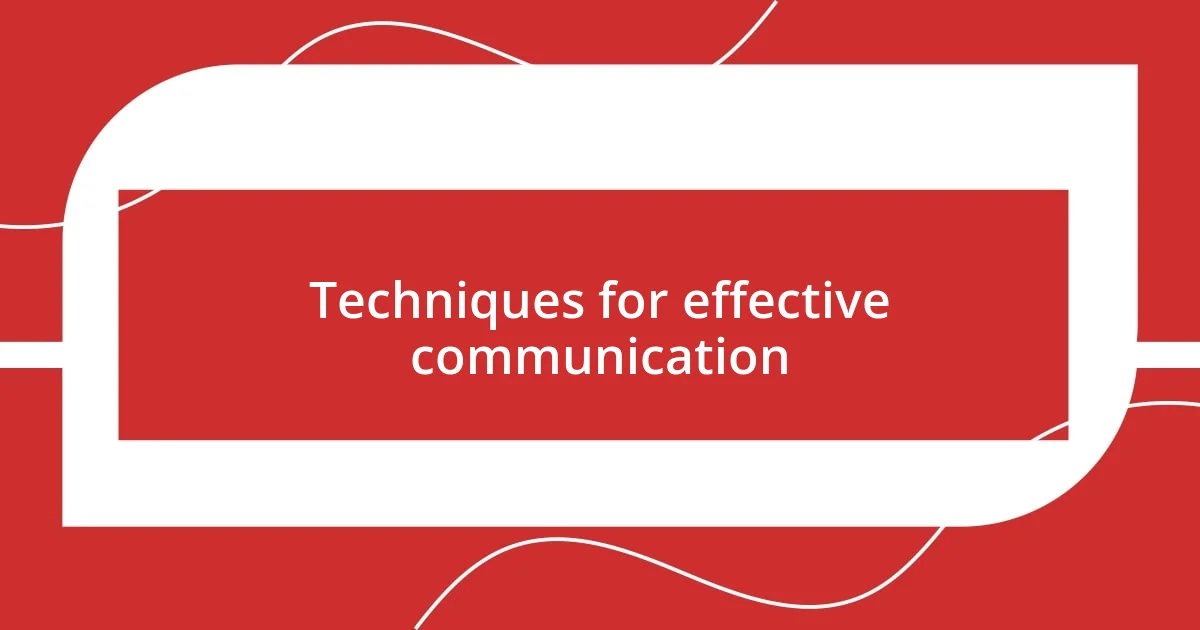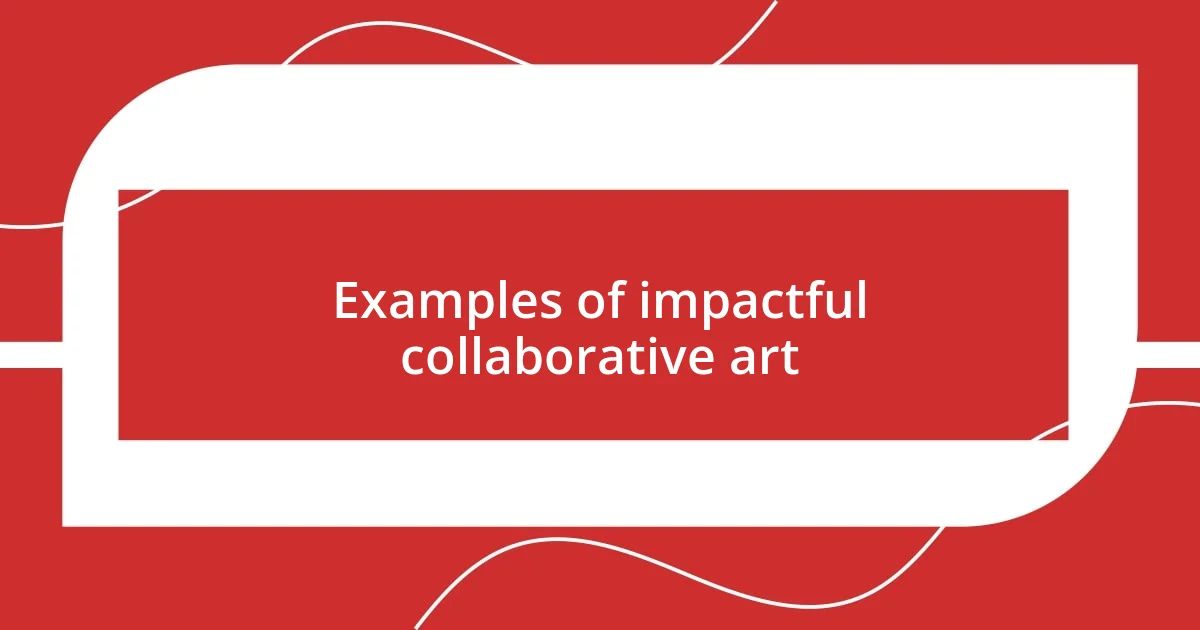Key takeaways:
- Collaboration enhances creativity by blending diverse perspectives, leading to innovative outcomes and unexpected ideas.
- Effective communication, including open discussions and constructive feedback, is essential for successful collaborative art projects.
- Embracing challenges and adaptability fosters a supportive environment, turning obstacles into opportunities for growth and deeper connections among artists.

Understanding collaborative art processes
Collaborative art processes are fascinating because they blend diverse perspectives into one cohesive piece. I remember working on a mural with a group of friends, where each brushstroke reflected our unique backgrounds. Isn’t it incredible how different styles can come together to create something entirely new?
In my experience, the beauty of collaboration lies in the unexpected outcomes. For instance, during a group project, an idea that initially seemed odd ended up being the highlight of our piece. How often do we overlook the potential of unusual ideas simply because they don’t fit our personal vision?
Moreover, communication is at the heart of any successful collaborative art process. I’ve found that discussing our visions openly not only enhances creativity but also deepens connections between the artists. It’s amazing how sharing our thoughts can turn a simple project into a shared journey that resonates on an emotional level.

Benefits of collaboration in art
The benefits of collaboration in art are numerous and profound. For me, one of the most significant advantages is the opportunity for skill exchange. When I collaborated on a photography project, a fellow artist taught me techniques for capturing light that I had never considered before. This exchange not only improved my skills but also enriched my creative process in ways I hadn’t anticipated. Have you ever experienced a moment where someone else’s expertise transformed your approach to your work?
Another benefit that stands out is the enhanced creativity that blooms from teamwork. I recall a project where we blended traditional painting with digital art. The synergy of ideas propelled us beyond our individual limitations, leading to innovative compositions and fresh perspectives. It’s incredible how collaboration can serve as a catalyst for creativity, pushing us to explore avenues we might never try alone. Have you noticed how working with others can spark new concepts that surprise even you?
Finally, collaboration fosters a sense of community among artists. Participating in group exhibitions, for instance, has connected me with a network of creative individuals who share not just ideas, but also support and encouragement. It’s heartwarming to see how collaboration can build relationships that extend beyond the canvas. Isn’t it wonderful how art can unite people with a common passion?
| Benefit | Explanation |
|---|---|
| Skill Exchange | Working with others allows artists to learn new techniques and expand their skill sets. |
| Enhanced Creativity | Collaboration encourages innovative ideas that can lead to unique artistic expressions. |
| Sense of Community | Collaborative art builds supportive relationships and connections among artists. |

Key elements of successful collaboration
Successful collaboration thrives on a foundation of trust and respect among artists. From my own experiences, I’ve discovered that when we genuinely value each other’s contributions, the creative process flows more smoothly. I remember a time when a fellow artist suggested a radical color palette for our community mural. Initially, I was hesitant, but trusting their instincts led to a vibrant work that truly captured our vision. This moment taught me that listening and embracing diverse ideas can lead to phenomenal clarity in our collective expression.
The key elements of successful collaboration can be distilled into a few essential practices:
- Open Communication: Regular and honest discussions foster understanding and align expectations.
- Flexibility: Willingness to adapt ideas encourages more dynamic and innovative outcomes.
- Shared Vision: Establishing a mutual goal creates cohesion and motivation within the group.
- Active Listening: Valuing each participant’s input promotes trust and nurtures creativity.
- Empowerment: Allowing each artist to take ownership enhances the overall investment in the project.
These practices have been fundamental in shaping the most rewarding collaborative experiences for me, transforming what could have been a series of individual efforts into a memorable journey fueled by passion and connection.

Techniques for effective communication
Effective communication is the lifeblood of any collaborative art endeavor. In my experience, using visual aids, like sketches or mood boards, can clarify ideas that might be stuck in someone’s head. Just last month, I worked with a group where one artist shared a simple line drawing that captured the essence of what we wanted to create. It was such a game-changer! Suddenly, our discussions shifted from vague concepts to a tangible vision we could all see together.
Another technique I find incredibly valuable is setting aside time for regular check-ins. This practice nurtures an environment where everyone feels heard and valued. I recall a multi-artist sculpture project where we dedicated just a few minutes at the start of each session to share our thoughts. That small ritual not only strengthened our connection but often sparked unexpected ideas. Have you ever felt how just a brief moment of sharing can light the way to more profound insights?
Lastly, embracing constructive feedback makes a world of difference. I remember feeling nervous sharing my work during a group critique, but what I received was not just criticism but collective wisdom. It made me realize that everyone’s perspective is a piece of a larger puzzle. How often have you thought about the power of feedback in refining your artistic vision? Keeping this in mind encourages growth, both individually and as a team, and transforms our art into a true collaboration of ideas.

Navigating challenges in collaborative projects
Navigating challenges in collaborative projects requires a balance of adaptability and patience. I recall a specific instance where conflicting ideas around our project’s theme initially caused frustration among team members. Instead of allowing that tension to fester, we turned it into an open discussion, which ultimately strengthened our vision. Sometimes, I wonder, what would happen if we embraced these conflicts as opportunities for growth rather than barriers?
It’s also crucial to set realistic expectations, as unspoken assumptions can lead to misunderstandings. In one project, I assumed everyone shared the same timeline, but it turned out that not everyone could commit the same hours. This misalignment created some stress initially, but once we recalibrated our timeline together, I felt a sense of relief wash over me. Have you experienced that moment when everyone finally gets on the same page? It can feel like a collective sigh of relief!
Lastly, I believe that fostering a supportive environment makes a significant difference when navigating challenges. During one collaborative project, we encountered a particularly tough design hurdle. Instead of pointing fingers, we celebrated small wins along the way, which kept our spirits high. I often ask myself, how can we nurture an atmosphere where setbacks are viewed as mere stepping stones? This mindset truly transforms the collaborative experience into one of resilience and inspiration.

Examples of impactful collaborative art
One of the most memorable examples of impactful collaborative art I’ve experienced was a community mural project. A group of artists, along with local residents, gathered to transform a dull brick wall into a vibrant celebration of our neighborhood’s history. We each contributed different elements, from colorful motifs representing cultural heritage to abstract designs that reflected personal stories. Watching the mural come to life was breathtaking; it felt like we were weaving together our individual voices into a collective narrative. Can you imagine how empowering it is for a community to see their stories visually represented?
In another project, I participated in an international online art show that paired artists from different parts of the world. We worked on a theme of unity in diversity, sending our pieces back and forth for feedback. Each artist brought a unique cultural perspective, infusing the transformations with rich textures and colors that I found fascinating. It challenged me to rethink my artistic approach, as I realized how much I was learning from others. Don’t you think there’s something magical about seeing how diverse influences can come together to form a single cohesive artwork?
I also think of a collaborative performance piece I was part of, where dancers, musicians, and visual artists worked together to create an immersive experience. Each rehearsal felt like an exhilarating dance of ideas, where our individual contributions intertwined seamlessly. We learned to listen deeply to each other, and that openness sparked creativity I didn’t even know I had. Isn’t it remarkable how working alongside talented individuals can push you beyond your creative limits? This experience not only strengthened our final presentation but also forged meaningful friendships, enriching our individual artistic journeys.

Encouraging creativity through collaboration
When I collaborate with others, I often find that my creativity flourishes in unexpected ways. There was one time I joined a sculpting workshop where each artist was tasked with contributing a section to a larger piece. As we discussed our ideas, I felt a rush of inspiration from my peers’ interpretations. The moment I saw how my simple concept sparked ideas in others, I realized that collaboration does more than share workload; it ignites creativity.
Imagine being in a brainstorming session where different viewpoints collide, sometimes chaotically. I remember a time when brainstorming ideas for a community art exhibit included artists from various backgrounds. Initially, it felt overwhelming, but as we voiced our opinions, I noticed how the fusion of our distinct styles began to paint a broader picture of what we could create. Isn’t it amazing how creativity can thrive in such a vibrant melting pot?
Additionally, I’ve learned the importance of vulnerability in encouraging creative expression. During a collaborative painting event, I hesitated to share my initial sketches because they felt too raw. But when I finally opened up, I found others felt the same way. This shared vulnerability melted away barriers and opened doors for honest feedback. Have you experienced that exhilarating moment when revealing your true self leads to an explosion of creativity around you? Embracing that vulnerability can transform the creative process into something magical.















